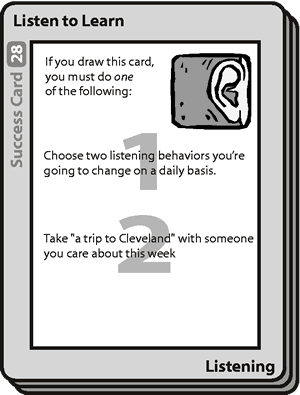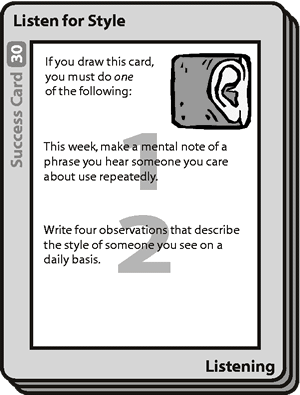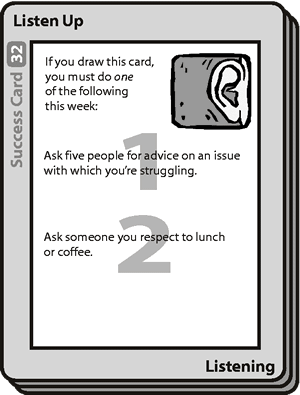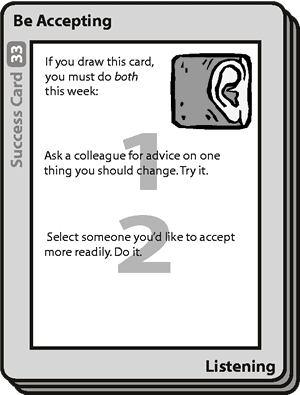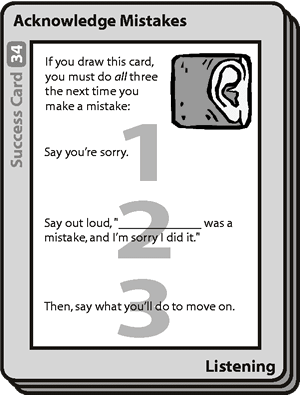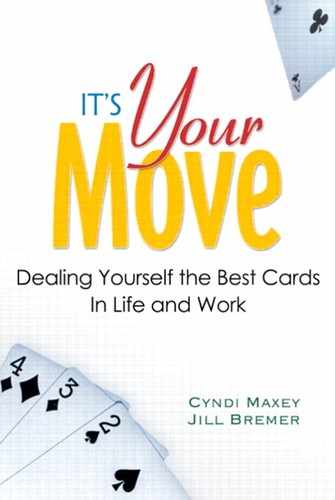Listening is at the center of every move you make and, therefore, one of the most challenging hands to play. Listening will distinguish you as a key player, move you toward your goal, and establish your success. Nobody succeeds alone. You make decisions and choices based on listening to others. Dramatist Wilson Mizner once said, “A good listener is not only popular everywhere, but after awhile he gets to know something.”[1] The good listener is popular and does learn a lot, yet when you ask people what causes communication problems in their lives, many will say, “Nobody listens.” Social psychologists such as Ralph Nichols have studied listening valiantly since the 1950s, and it continues to be one of the most requested topics of today's professional development seminar audiences. No role in life or work can be successful without listening. No successful move can be made without listening.
If you've been in the game for a while, you've probably developed some habits that reveal your listening skill. Which habits are most like yours, those in column A or B?
If you're like most people, you can relate to both sets of statements. When asked to rate themselves as listeners on a scale of 1 to 10 (10 = excellent), most people give themselves a 7. Would your rating be similar? Is a 7 good enough? How is it that you can achieve excellence—a 10, perhaps—in sports or cooking or computer technology but listening excellence somehow evades you? Writer Edgar Howe once said, “No man would listen to you talk if he didn't know it was his turn next.”[2] Perhaps you're so busy talking that you forget that listening is 50 percent of the communication process, or maybe you think that listening should just come naturally, as a matter of course. Actually, you are equipped only to hear. You have to learn to listen. And you also have to listen to learn.
There are some myths about listening to let go of and some truths to build on. The myths tend to perpetuate bad habits. When you play the Listening Hand, you must believe and play the truths to win.
The truths about listening are simple. You could have been brought up to think that listening is a nice, polite thing to do, and it is, but it's also a wise thing to do. Good listeners are smart because they are constantly taking in all kinds of information. When you listen well, you can't help but learn. Listening attaches meaning to the physical process of hearing; it allows you to make sense of everything you do. Listening is as active a process as driving a car on a snowy day. It takes the same amount of energy and concentration to listen well as it takes to watch how the car's windshield wipers clear the ice, to time the brake at the stop, and to test the iciness of the pavement. Listeners have power in relationships because they have understanding. They've gathered information and details that many might have missed. You're not born with an ability to listen. You have to learn and practice the skill. The truths are simple, but the skill of listening is complex.
How do you begin to play this hand successfully? The first step in learning to listen better is awareness. When you catch your thoughts drifting or your anger building a defense, you are aware. When you realize that a certain client's explanations always require your note taking, you're aware. When your child says to you, “Dad, you aren't listening to me!” you're aware. It's a larger first step than you might think. Too many people deny they have a problem. Be happy to be aware. Awareness will help move you to the second step, which is behavior change.
Anthony made the move from awareness to behavior change by altering a few simple daily habits. Imagine how it would feel if every time you walked into someone's office, he or she would turn directly to you or perhaps even pull out a note pad? In today's highly computer-based environment, it's easy to get lost in the computer screen. The first evidence of listening is eye contact. Make the choice to break your gaze with the screen and look up. With only a few cultural exceptions, looking in someone's eyes shows respect and caring. It's an easy behavior change to make if you're committed to concentrating.
Ellen learned to listen from years of experience answering library patrons' questions about the unknown. She simply couldn't function effectively in her job role without listening. For a librarian, the need to listen seems fairly obvious, but how about for you? In your life and work, can you afford not to listen? Think of all the ways that listening can make you more successful. If you're chairing a school event, why not call the past few chairpersons and listen to their experiences? If you're taking on project management, consider calling team members individually to get their input before you have your first group meeting. If you're applying for a new job, call someone who works for the company and listen to their experiences. If you're a working parent, feeling rushed at home, make a concerted effort to focus on only your family at dinner. Ask them about their day or how they feel about a current event. Focusing on them will build your spirit together.
What Sharon learned listening to her son in the uninterrupted environment of a car on a trip to Cleveland was a precious lesson in remembering what was important in her life. Taking the time to listen to someone important to you without distractions is a true gift—not to him or her, but to you. It allows you to fully receive who he or she is.
Perhaps you've heard of the classic communication theory of “the stranger on the train”—the phenomenon of the unwarranted amount of self-disclosure that occurs between two strangers who know they will soon part, never to see each other again. Why is it easier for strangers to share and listen than for those who are close? The answer is simple: Less risk is involved. Deep feelings don't have to be explained; they're just expressed. Mistakes and snafus are shared as normal, accepted parts of life. They don't have to be justified. There is less risk in sharing because there is less judgment on the listener's part.
You could find it difficult to self-disclose to anyone but your longtime friends and family. Try to keep an open mind. Try sharing easy things about your past or your opinions. When you're able to share more about yourself with a new acquaintance, make a mental note to remember how freeing it felt to share without being judged, reprimanded, or corrected. Try to allow that feeling to occur with those who mean a lot to you, both at home and at work. If you're a manager, you can open up more to your team. Did you know that most managers don't know simple things about their employees such as where they grew up or what their hobbies are, let alone how they really feel about the weekly meeting? Whatever your role in life, you can focus more on listening. What kind of listening environment have you created around you? With whom do you need to “take a trip to Cleveland” in some way?
If you've just made a move to a new project, job, or volunteer team, you'll find that experienced people are usually willing to talk. They're not always willing to talk about the positive things, however, and often you'll meet the most jaded, unhappy people on your first day. Listen openly, without making quick judgments. You'll be able to pick up cues to the type of culture surrounding you by listening to how things are described. People unknowingly give you cues to how they're used to operating by everything they do and say. If you listen, the cues aren't difficult to find.
Catherine was happy to be entering such a positive, civil environment among consultants. The senior consultant who apologized sent a strong positive message that ten minutes meant a difference in her ability to serve her internal customers. Language tells you a lot about the other people in the game. You can listen for the order of what is covered in a conversation. Are details covered first? Do problems surface without solutions? Is the information a surprise? You can listen to the way language is used. Is it casual or very planned and articulate? How would you describe the overall tone of the information? It could be very logical and ordered or very creative and unstructured. Is there a serious or humorous tone?
Listening to language well also allows you to be able to ask questions well. If you can paraphrase or check in with someone about what you understand, you are demonstrating an ability to listen. You ought to be able to ask questions such as, What do you mean by that? or How does that work? or Why is that? Most people aren't very good explainers. You have to help them explain.
Linda was having difficulty getting Joe to explain his situation. Often, when you're new to the game, as Linda was in her new business, listening is a challenge because you have so many other things you're worried about. Most people feel nervous about first meetings: first days with a new client, first-time social events, and first days on the job. In Linda's case with the evasive Joe, attempting to probe was a good choice. Even though her questions didn't lead her to essential information, they enabled her to better prepare for the next meeting. She can call colleagues and ask them for advice with similar companies or experiences. She can return to Joe's company and research personnel records on her own. There are other ways to get the information she needs, and, in the process, she could discover why Joe knows so little about his employment trends.
Many times, changes in work coincide with changes at home; for example, relocation, new schools, new bills to pay, and different transportation. If you're in a new work position where it seems you have lists and lists of questions, try to keep them geared professionally. For example, if you're concerned about getting off work in time to pick up your child at school, ask about the best bus route or the easiest parking lot to use, but don't include your personal worries. Keep your mind on your goal as you ask probing questions and listen for responses that move you toward it.
If you've made a move to a new group at work or in your personal life, you could hear a lot of jargon that is new to you. Professional, school, and community groups are all guilty of tossing around abbreviations and acronyms that experienced members understand. Publishers call a book that's not as good as others in its market “a brown suit.” Speakers and actors talk about bookings, agents, bureaus, and exclusivity. Business managers discuss ROI (return on investment), the game plan, the cash flow, the market leader, getting buy-in, and crisis management. Human resource professionals discuss empowerment, being job ready, outsourcing, and outplacement services. When you're listening to the language around you, you'll be able to learn a lot about the attitude and awareness of your team members. Ask when you don't understand something; chances are that someone else doesn't get it either.
Everyone is different. Hippocrates first talked about temperament styles in 400 B.C. His model classified four body humours that resulted in four different temperaments: choleric, sanguine, phlegmatic, and melancholic. As time went on, researchers including the Greek physician Galen, the German philosopher Kant, and the American psychologist William Marston continued to describe personality and emotions in four types or categories. Today, it is widely accepted that people have different ways to succeed in their environment. It's been proven over the centuries: If you listen for style, you will get along with people better.
Generally, you'll find it fairly easy to observe categories of people. There are those who are more direct versus indirect in how they approach you. Some people focus more on the work itself and others on the people who do the work. Some people are detail oriented; others like to think in big pictures. Some make decisions quickly; others need to think things through. Some people like to discuss thoughts; others prefer giving orders and instructions not to be discussed. If you observe and listen to others' behavior over time, you can adapt. Often someone's appearance will match his or her behavior. For example, an expensive suit and impeccable grooming will accompany elevated vocabulary and perfect grammar. But sometimes the two elements don't match up at all. Mixed messages in any combination should always cause a red flag—a caution signal—to go up for you. Keep your eyes and ears tuned in for the real truth about the other person's style; it will reveal itself to you if you're open to seeing it.
Style is evident in behavior. The keys to style awareness are to use your strengths, continually be open to opportunities for improvement, and adapt to others' styles. For example, if you're a detail-oriented type, be willing to work with people who have sloppy desks and no to-do lists. It can take counting to ten, some deep breathing, and trial and error, but you can do it. If you're outgoing and talkative, be careful not to overwhelm a quiet type. Try to ask questions and listen. Don't overwhelm your manager who is a big picture thinker with daily operations data. Listen and observe constantly. You'll discover things about people every day. For example, your personal assistant could enjoy data gathering but be uncomfortable with selling ideas. You can tell because you've listened to what he or she says about difficult client calls or new software tricks. Listen for what people say and do the most. You will discover their natural style as you listen, and you can encourage them to use their strengths.
Although you could never have to listen to style with the intense concentration that Joan uses selecting voice-over actors, you can certainly listen for revealing sound bites: those meaningful cues to personality and naturalness that everyone in your life shares on a daily basis. The more evidence you find of someone's natural style, the easier it is to choose the right move with that person.
Any experienced cardplayer knows how much information is revealed by the slightest nonverbal nuance of the face. Any actor knows the amount of information revealed without words. Film actors, especially, are skilled in reading and reacting to body language. But there's a professional and personal place for listening to nonverbal communication as well.
Mary's experience as an advertising executive reflects the importance of face-to-face listening for clarity and creativity. Human communication would be so much easier if you could simply “mind meld” your thoughts directly into the other person's brain and not have to be bothered with listening to words and body language. The reality is, however, that body language actually reveals more than words. You can control what you say, but it's difficult to control your body; it sends out messages all on its own. What happens then? It's another case of congruence versus mixed messages. When the verbal and nonverbal don't match, we tend to believe the nonverbal.
When you listen with your eyes, tune into the other person's posture, gestures, eye contact, and facial expressions. Posture reveals attitude and level of interest in both the topic and you. What is the person's posture “saying”? Is he or she showing interest by facing you directly, or does he or she look suspicious with a sideways stance? Is the person slumped over, looking submissive or uncertain? Or is he or she filling the space with his or her body and exhibiting dominance and confidence?
You use gestures to help others understand. Have you ever tried to converse with someone who doesn't speak your language? What's the first thing you do? You use more gestures! Gestures are used to emphasize and clarify the spoken word. Palms up movements help propel the message toward the listener. Palms down gestures convey both emphasis and a mood of calm. Take note of gestures that reveal nervousnes—wringing hands, palm rubbing, and other movements directed toward the body. Rapport can be enhanced when gestures become somewhat synchronized. Conversational obstacles can often be overcome when the listener reflects the speaker's movements.
Eye contact is probably the most powerful form of nonverbal communication. In his book, Eye to Eye: How People Interact, Dr. Peter Marsh says, “How we look at other people, meet their gaze and look away can make all the difference between an effective encounter and one that leads to embarrassment or even rejection.”[3] The ability to look directly at people and meet their eyes can help to make a positive impression. Honesty and the ability to look someone in the eye are also very closely related. If you're listening, you're expected to look at the speaker. As you look, consider his or her eye contact with you. Is he or she checking with you periodically to gauge your interest? Or is the person establishing authority over you by limiting the length of eye contact and frequency of glances? Eyes are very reliable mood indicators. It is difficult to fake genuine eye signals, so trust your intuition as you “read” another's eyes.
The reality about facial expressions is that, even when they're bad, they're good. An expression of any kind at least shows that people are involved. Be aware, though, that humans have become quite good at suppressing the display of some feelings and amplifying others. Researchers have come to agree that there are six basic emotions: happiness, sadness, anger, disgust, surprise, and fear. Interpretation of these emotions can be difficult because each one often appears in only one part of the face, either the lower face, eyes, or brows. The other two parts could be registering something completely different, as in a smug look, a combination of angry and happy expressions. Most people are skilled at manufacturing whatever expression society has deemed appropriate, so posed expressions are commonplace in many conversations. Eyebrows rise when surprised, “social smiles” are exchanged when agreeing, and jaws drop when astounded. It's often impossible to distinguish between conversational signals and true expressions of emotion. Consider facial expressions as a piece of a much larger communication puzzle.
If you report to a manager, you know you have to listen to him or her. How well do you listen up? Do you listen without defensiveness? Are you accepting? Do you ask for more input? Asking for feedback is a mark of healthy self-esteem. If you have the courage to ask for help, you have the courage to take the next step. Superiors, especially, appreciate it when you seek their expertise, as long as you don't abuse their time. How you follow up to the feedback is just as important as asking for it, but asking is the first step.
If you're good at your game, experienced, and successful, you still have opportunities to listen up. You can seek a mentor or circle of support among colleagues who are also good at their games. Sometimes called forum, mastermind, or support groups, these are selected groups of respected people who share common goals and standards.
Christine not only practices listening up on a regular basis to build her own business; she advises her clients to do the same. Who can you ask for advice? Whom in your life and work should you be listening to more intently on a daily basis? What are successful people doing that you're not? Don't be afraid to make the call. Most people love to talk about what they do.
True listening is listening without defensiveness or judgment. It is open and accepting. A good listener remains open not only to the ideas before him or her but also to the possibilities. If you're listening to the possibilities, your mind is open and creative. You're using your thinking time well because you're taking what's before you and moving it positively toward a goal you have.
Like Mary Ann, the alderman, Christine, the business consultant, and Karen, the shop owner, you too can be accepting and open to the information that the people you interact with have to offer. If you don't ask, you'll never know. People you've listened to like to watch their ideas turn to action. Self-discipline is important so that you can move from acceptance to action. Listening takes energy.
If you've ever worked in a customer service role, you know that the first step in handling an angry customer is to say you're sorry. It's also a good listening step. It sets up equality between you and the speaker. It shows you're willing to listen to the next idea or step to solve the problem.
If you truly can't listen, say, I'm sorry, but I'm having trouble listening fully right now; I've got something else on my mind. Or Joe, this sounds really important and I'm having a hectic day. Can I call you back tomorrow? It's much better to acknowledge your mistakes and limits than to fake your way through a situation only to regret it later. Likewise, if you're truly sorry, say so. It will open you up to better listening, and the other person won't be so defensive.
William acknowledged his mistake directly; you can send a note, offer an alternative, offer to learn more, send a gift, apologize in front of a group, or use any tactic that will let people know that you care. Very few days go by without opportunities to learn from listening. Whether you learn about someone else, yourself, your world, or your specific situation, you have opportunities to practice being a better listener every day. The next time someone asks you to rate yourself as a listener, wouldn't you like to say, I'm a 10?
You've now played the Listening Hand. The best way to become a better listener is to practice listening a lot. So it's time to draw one of the cards following for your first move. With this hand, you might not feel very active, but remember that listening well is one of the most energetic activities in the game. Write your card choice in your game plan at the end of the book. When you've completed the move, return to the game plan to fill in the results.
